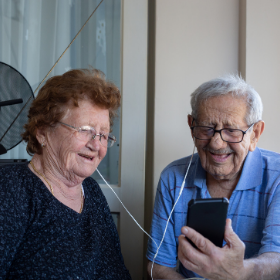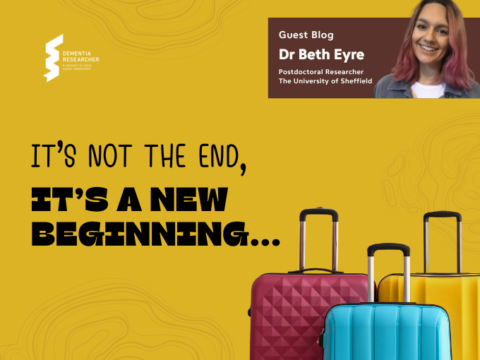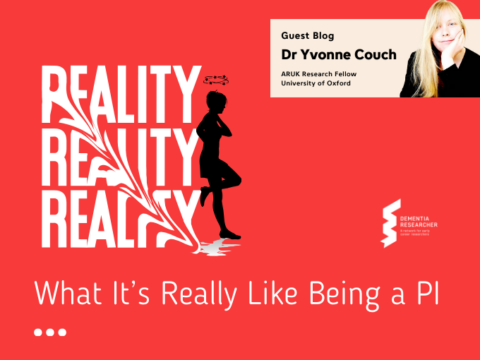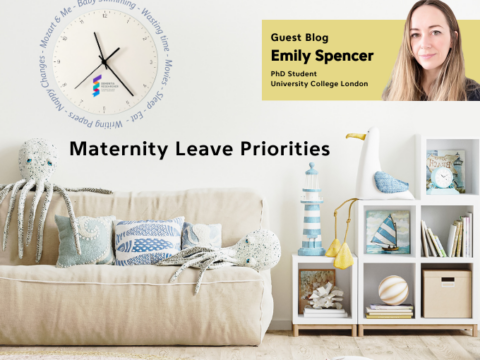We are Research Fellows on the NIHR funded Dementia-Person Aligned Care Team (D-PACT) project, which aims to develop and evaluate a person-centred Dementia Support Worker (DSW) intervention based in primary care. Interviewing people with dementia and carers, about their experiences of receiving the support intervention, has substantially informed our learning during the feasibility phase.
In May 2019, Sarah wrote a blog exploring challenges of enabling people with dementia to meaningfully participate in qualitative research. Since then, further challenges and opportunities have emerged due to covid-19. The team have had to rapidly adapt the D-PACT intervention to enable remote delivery, and switch to remote, rather than face to face (F2F) data collection processes.
In this current blog, we share our reflections on the challenges that remote interviewing caused and practices that addressed these. It is our hope that this blog may foster further discussion about suitable/helpful approaches to interviewing people with dementia and carers, both during the pandemic but also during more normal times too.
Remote conversations can be tiring, especially for people with dementia.
We have all noticed that communicating virtually is more tiring than F2F, and some have suggested this is because we miss out on a lot of subtle non-verbal communication that allows us to process other peoples’ motivations, emotions and so on . For people with dementia, who already have difficulties with language processing, this feeling of hard work and fatigue is likely to be amplified. We found that it was even more necessary to take a flexible approach, which involved being prepared to reschedule the interview, take more breaks than normal, and to substantially cut down the length of the interview if necessary to do so. To be able to react in this way we put more time aside for the interview and identified key questions that would need to be prioritised. During the interview we also maintained a relaxed approach, reassuring carers that if the person with dementia wanted to wander away from the communication device at any time (which often happened), this was absolutely fine.
Researchers rushing the interview due to time pressures
When interviewing remotely, it can be tempting to rush the everyday conversation aspects of the interview, so that the business of the interview can be conducted before people get tired. To counteract this, it can be helpful to have a pre-interview remote call. During this first call it can be made explicit that this initial conversation is about getting to know each other, discussing what the interview might involve and to plan a date and time. Showing a warm and genuine interest in how things are, how people have been coping in these unusual and isolating times, their pasts, interests and values, brings a sense of normality. Interviewees often report to us that in this, often frightening, era the Dementia Support Worker has provided a vital link to make them ‘feel normal again’ as well as less lonely. We hope to mirror this sense of person-centredness in our own (researcher) interactions with people with dementia and carers. In line with a coaching approach (that is core to the D-PACT intervention), we aim to make the delivery of research questions seem less like running through a checklist, and instead feel part of a natural conversation. In some ways this is much easier to achieve remotely, when interviewees cannot see you looking at an interview topic guide.
Distress caused by interviewers speaking to carers on their own
There have been some triad interviews (researcher, person with dementia and carer) where we have spoken with participants one at a time. In one instance, this approach had been agreed at an initial phone call, and the carer started talking to the interviewer first. However, the person with dementia became distressed, worrying over what was being talked about. The interviewer suggested that the carer swapped; letting the person with dementia talk first (a very general conversation as specific interview questions were difficult in this case). Once this had happened, the person with dementia was happy to leave the carer to it. It is important to adapt to what is happening in the moment.
Communication difficulties
In F2F interviews using visual resources is often essential for explaining the interview purpose, e.g. showing a photo of the Dementia Support Worker, and writing down key phrases e.g. ‘How is it going with ?’ ‘How has helped you?’ ‘What is good/not good?’ Otherwise, some people with dementia can get confused about the purpose. In one case, we soon realised that a person with dementia thought that the researcher was there to provide support for him, rather than find out about the support he was receiving (which is quite an abstract concept), exclaiming mid-interview ‘This just isn’t helping me!’ Use of visual resources is most effective when F2F, sitting alongside and looking at/pointing to the same things. Supporting conversations in this way has proved really challenging remotely. To try and counteract this we have sent materials in advance, but this did mean that the spontaneity of being able to quickly write a key word, draw a simple picture, or point to something in the immediate environment, to support comprehension, was lost. Sharing of resources in the moment is an area that we would argue needs better digital solutions, which would be beneficial for practitioners as well as researchers.

Technology isn’t the only barrier to effective interviews.
Where possible, we tried to enable people to engage with practitioners and researchers via video. Although there are many ways in which remote interviews might be inferior to F2F ones, if the comparison is between the two approaches in Covid-19 times, a huge advantage of remote video interactions is that no one has to wear a mask, so facial expressions become available and potentially people look less scary. No one has to worry about whether the person with dementia is able to observe social distancing. Not everyone had internet access however, so some interviews have had to take place by phone. This made it difficult to gauge how people were feeling (tired/confused/engaged, etc.,) through observing and mirroring non-verbal communication: exchanging smiles and so on.
Adapting to hearing difficulties is also more difficult when visual cues are removed and we needed to be mindful that speaking louder is not a good strategy in this situation. It can lead to exaggerated, hard to understand speech. Also sounds typically hard to hear are voiceless (e.g., ‘s’, ‘sh’ and ‘f’) and will not be enhanced by increased volume. In phone interviews we have had to try and compensate for the complete lack of visual feedback by ramping up linguistic methods e.g. ‘Was that clear?’, ‘Let me know if you are getting tired’ etc. Sometimes participants are happy to use the loud speaker function so that a three way conversation can take place. In some cases this works well, with the carer allowing space and offering support for the person with dementia to contribute. In another cases, this can prove difficult, especially when there is much simultaneous talking, making transcription tricky.
Imbalanced perspectives in triadic interviews
During F2F interviews in peoples’ homes, we found opportunities to obtain individual interviewee perspectives, even during triadic interviews. Important and personal information might be revealed when one participant has gone to make a cup of tea, or when showing the researcher to the door at the end of the interview. This can help interviewers gain different insights and provide opportunities to probe a little more without fear of upsetting the other participant. Remote interviews do not lend themselves so readily to these opportune moments, even though at times the interviewer may sense there are perspectives left unexplored, as the following researcher reflection highlights.
Researcher reflection: ‘….it struck me there may be things the daughter wanted to say without mum present. She did speak a little of her own past tendency to control things and make sure her mum was presenting all the facts correctly, and how she has learnt to let go of that since talking to the Dementia Support Worker. However, I think she saw her role in the interview as solely to support her mum, even though I emphasised that we are interested in both their views. I thought she might want to say more about the impact of the Dementia Support Worker for both of them, so I asked if she would like to email me after the interview if she thought of anything else she wanted to say. I stressed that this offer was for both of them – via the daughter emailing.’
Since this interview, we have routinely offered the option of post-interview emails in order to leave the door open to further reflections. However, we are aware that this could privilege carer views, as they are often more able to take up the offer.
As our study progresses, we continue to explore ways of enhancing involvement and engagement of people with dementia and carers in the qualitative research aspects. We hope that sharing these insights will contribute to planning a future with remote interviewing methods very much here to stay.
Authors

Dr Sarah Griffiths
Dr Sarah Griffiths is a Research Fellow at the University of Plymouth. A former senior lecturer on a BSc Speech and Language Therapy course at Plymouth Marjon University, and with a background in speech and language therapy . Sarah now researching Primary care based dementia support at the University of Plymouth.
You can follow Sarah on Twitter Follow @sgriffiths1966

Dr Hannah Wheat
Dr Hannah Wheat is a qualitative researcher with a background in applied health care research, working at the University of Plymouth. Hannah is particularly interested in how mixed qualitative methods can be used to develop, enhance and assess the design of health care interventions. She specialises in a method called applied conversation analysis, which involves examining how particular communication practices hinder or facilitate the achievement of institutional goals during interactions between professionals and service users..
You can follow Hannah on Twitter Follow @hannahwheat
This study is funded by the National Institute for Health Research (NIHR) Programme Grants for Applied Research (RP-PG-0217-20004). The views expressed are those of the author(s) and not necessarily those of the NIHR or the Department of Health and Social Care.
What have been your experiences of engaging with patients using online communication tools? Reply in the box below.

 Print This Post
Print This Post





[…] This blog is also published by the NIHR Dementia Researcher network: https://www.dementiaresearcher.nihr.ac.uk/guest-blog-interviewing-people-with-dementia-and-carers-re… […]